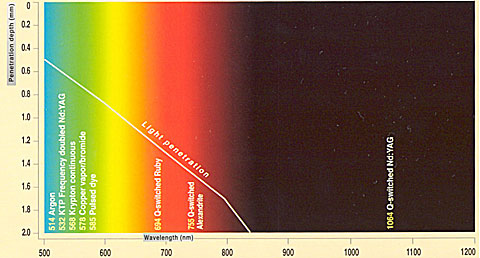There are many ways to categorise different lasers, and there is not a fixed or good system. For aesthetic skin lasers, the first broad division is separate them into ablative and non-ablative lasers. Ablative lasers target the water content in the skin and work by vaporising the top layers of the skin to remove blemishes, scars and wrinkles, and let the skin to heal and regenerate. Non-ablative lasers penetrate and work beneath the top layers of the skin without vaporising them.
Then we can classify them according to the mediums that are used to produce the laser, the wavelenghts of lasers produced, the sources of stimulation, the chromophores being targeted, and the applications.
Recently a new technology has been developed, where the laser is emitted by a scanner in a fractionated manner of numerous small beams. So a new category of non-fractional and fractional lasers is created.
- Ablative or non-ablative lasers
- Mediums (gas; chemicals; dyes; solid-state; metal vapour)
- Wavelengths
- Stimulation sources (electrical discharge; flashlamp)
- Chromphores (water; melanin; haemoglobin)
- Applications (pigment; tattoo; vascular; skin tightening)
- Conventional or fractional
Mixing these categorisation, we arrive at a simple but useful classification for the common lasers used in skin aesthetic treatments:
Ablative Lasers
- CO2 Laser (gas medium laser,10600 nm)
- Conventional
- Fractional
- Erbium-YAG Laser (solid-state laser, 2940 nm)
- Conventional
- Fractional
As mentioned, they target the water content in the skin, and the penetration is shallow. CO2 laser can make the skin contract, seal small blood vessels and so has a blood clotting property, which is very useful. Erbium-YAG laser vaporises an even thinner layer, but the drawback is, it does not have blood clotting property.
Applications:
- Skin cutting, replace scalpel
- Remove moles, naevi, warts, lumps
- Skin resurfacing, tighten skin, remove wrinkles, improve acne scar
Non-Ablative Lasers
- Pigment Lasers
- Pulsed Dye Laser (dye laser, 510nm)
- Ruby Laser (solid-state laser, 694nm)
- Alexandrite Laser (solid-state laser, 755nm)
- Nd-YAG Laser (solid-state laser, 532nm, 1064nm)
- Vascular Lasers
- Argon Laser (gas laser, 488nm, 514nm)
- KTP Laser (solid-state laser, 532nm)
- Pulsed Dye Laser (dye laser, 577nm)
- Nd-YAG Laser (solid-state laser, 1064nm)
- Skin Tightening Lasers
- Conventional
*** Diode Laser (solid-state laser, 900nm, 980nm)
*** Nd-YAG Laser (solid-state laser, 1064nm, 1320nm, 1440nm)
*** Infrared Laser (1100 – 1800nm)
*** Erbium-Glass Laser (solid-state laser, 1540 nm)
- Fractional
*** Fiber Laser (1550nm)
*** Infrared Laser (850 – 1350nm, 1540nm)

It looks very confusing indeed. As is said before, no one can know them all, even the experienced physicians. It is more important that the doctor knows his/her machines well, both in the effectiveness and limitations.
The pigment lasers have a short-pulsed (Q-switched), or long-pulsed mode, each has different indications. The targeted chromophore is melanin, or any dark-coloured pigment.
Main applications:
- Remove pigmented spots, such as freckles, café-au-lait spots, melasma
- Remove tattoo pigment
- Hair removal
The targeted chromophores of vascular lasers are oxyhaemoglobin, and cells of blood vessels.
Main applications:
-
Remove telangiectasia (red & blue lines)
- Remove birthmarks such as port wine stains, strawberry naevi
The skin tightening lasers are mainly lasers with mid-infrared wavelengths, and they target the collagen, and water content in the dermal matrix. The heat generated induces a partial injury, with subsequent dermal healing response and skin contraction. Normally some forms of cold protection is delivered at the same time, therefore no notable injury is done to the epidermis on top.
All lasers can do potential damages to the eyes and it is a must, for both doctors and patients, to wear protective eye-wears during the treatments.

We shall come across some of these lasers again in more details when we discuss the laser treatments.

